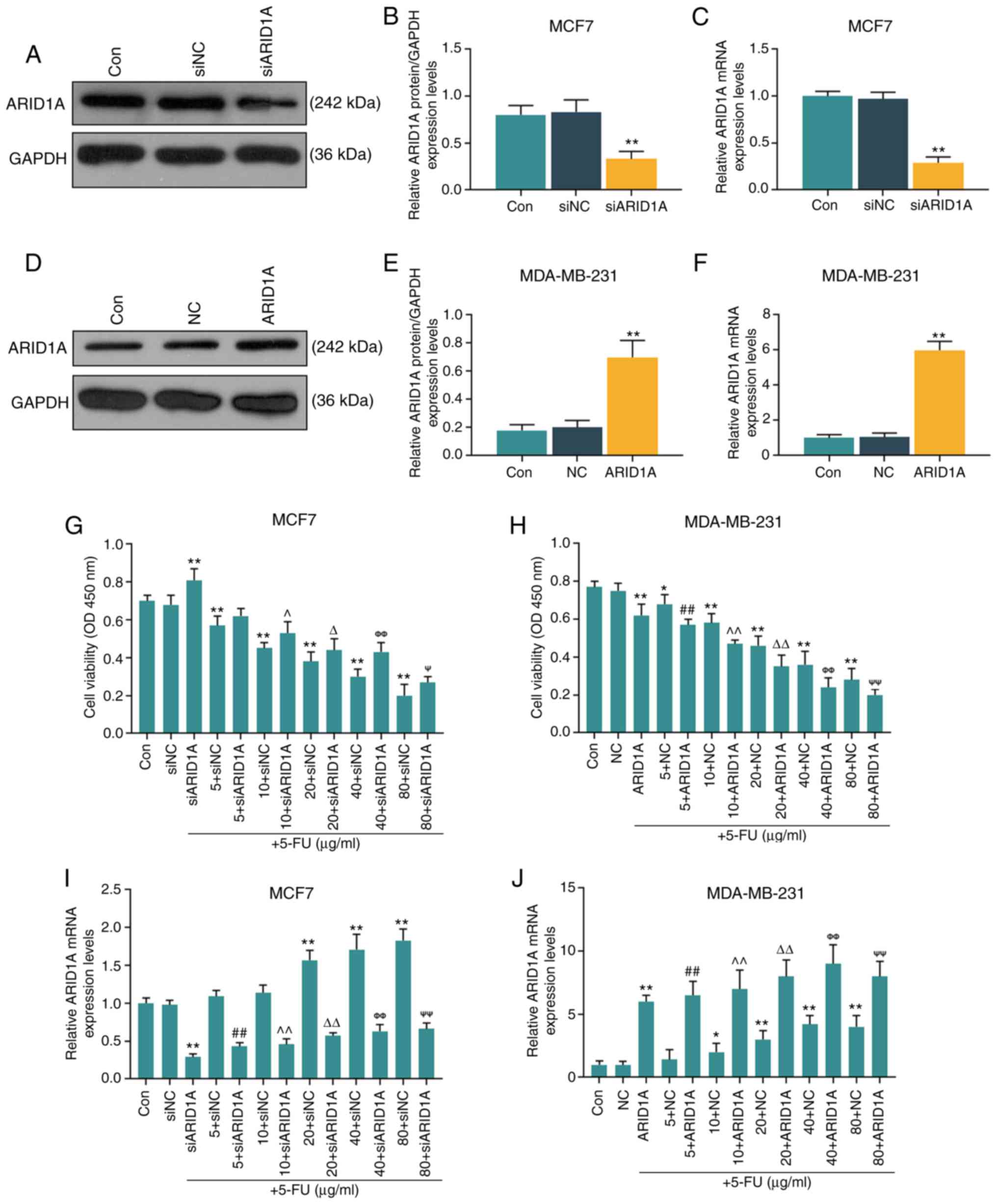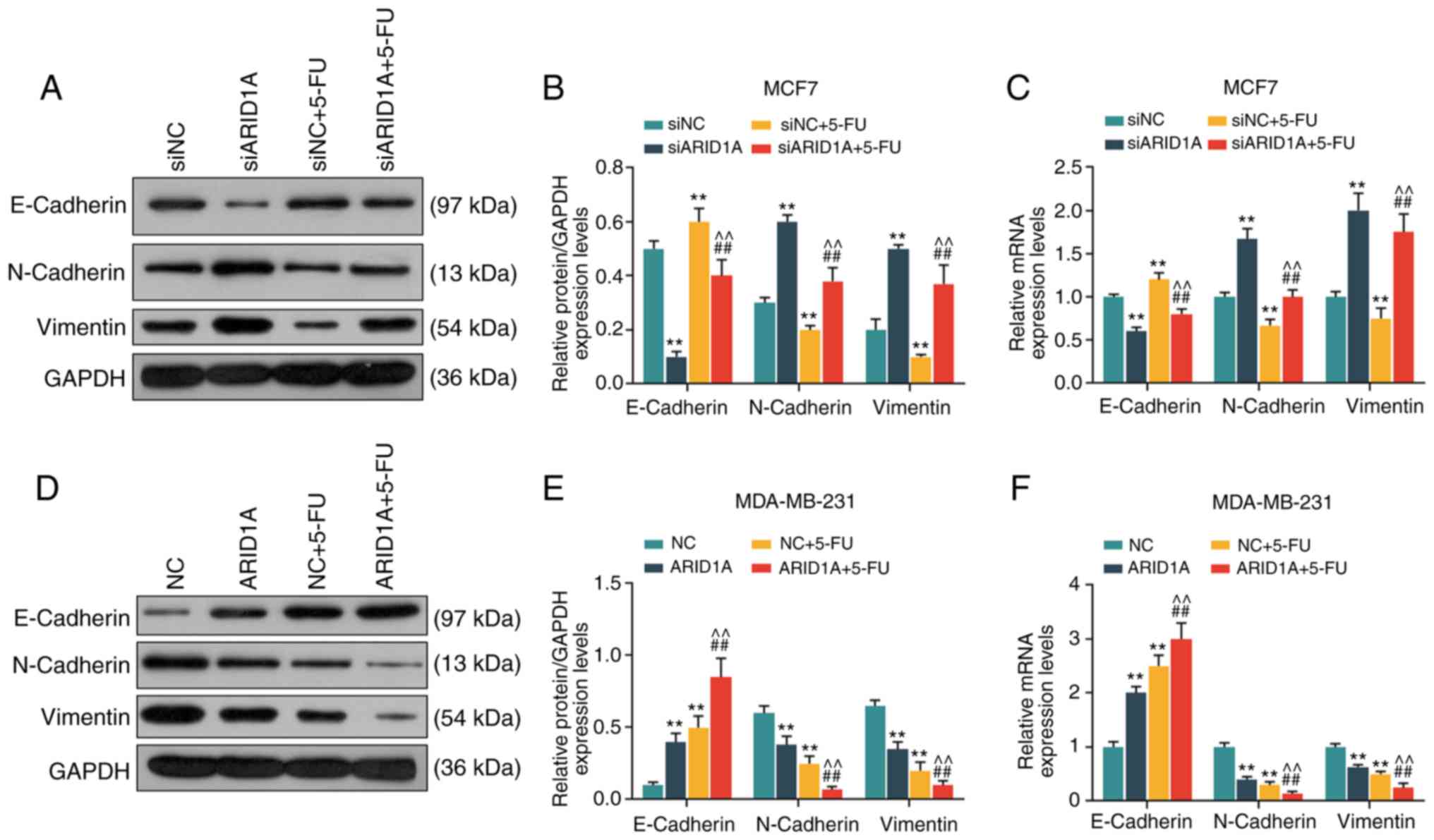|
1
|
Liang HF, Zhang XZ, Liu BG, Jia GT and Li
WL: Circular RNA circ-ABCB10 promotes breast cancer proliferation
and progression through sponging miR-1271. Am J Cancer Res.
7:1566–1576. 2017.PubMed/NCBI
|
|
2
|
Balekouzou A, Yin P, Pamatika CM,
Bishwajit G, Nambei SW, Djeintote M, Ouansaba BE, Shu C, Yin M, Fu
Z, et al: Epidemiology of breast cancer: Retrospective study in the
Central African Republic. BMC Public Health. 16:12302016.
View Article : Google Scholar : PubMed/NCBI
|
|
3
|
Calado A, Neves PM, Santos T and Ravasco
P: The effect of flax-seed in breast cancer: A literature review.
Front Nutr. 5:42018. View Article : Google Scholar
|
|
4
|
Yates LR, Knappskog S, Wedge D, Farmery
JHR, Gonzalez S, Martincorena I, Alexandrov LB, Van Loo P, Haugland
HK, Lilleng PK, et al: Genomic evolution of breast cancer
metastasis and relapse. Cancer Cell. 32:169–184.e7. 2017.
View Article : Google Scholar : PubMed/NCBI
|
|
5
|
Goodarzi H, Nguyen HCB, Zhang S, Dill BD,
Molina H and Tavazoie SF: Modulated expression of specific tRNAs
drives gene expression and cancer progression. Cell. 165:1416–1427.
2016. View Article : Google Scholar : PubMed/NCBI
|
|
6
|
Ketterer S, Gomez-Auli A, Hillebrand LE,
Petrera A, Ketscher A and Reinheckel T: Inherited diseases caused
by mutations in cathepsin protease genes. FEBS J. 284:1437–1454.
2017. View Article : Google Scholar
|
|
7
|
Butchbach ME: Copy number variations in
the survival motor neuron genes: Implications for spinal muscular
atrophy and other neurodegenerative diseases. Front Mol Biosci.
3:72016. View Article : Google Scholar : PubMed/NCBI
|
|
8
|
Jensen SM, Kumar S, Chowdhury A, Castro N,
Shih J, Salomon DS and Stetler-Stevenson WG: TIMP-2 inhibits triple
negative breast cancer growth and metastasis through EMT
suppression and promotion of vascular normalization. FASEB J.
32:678.6722018.
|
|
9
|
Raoof S, Mulford IJ, Frisco-Cabanos H,
Nangia V, Timonina D, Labrot E, Hafeez N, Bilton SJ, Drier Y, Ji F,
et al: Targeting FGFR overcomes EMT-mediated resistance in EGFR
mutant non-small cell lung cancer. Oncogene. 38:6399–6413. 2019.
View Article : Google Scholar : PubMed/NCBI
|
|
10
|
Li C, Wang J, Kong J, Tang J, Wu Y, Xu E,
Zhang H and Lai M: GDF15 promotes EMT and metastasis in colorectal
cancer. Oncotarget. 7:860–872. 2016. View Article : Google Scholar :
|
|
11
|
Chunder N, Mandal S, Basu D, Roy A,
Roychoudhury S and Panda CK: Deletion mapping of chromosome 1 in
early onset and late onset breast tumors-a comparative study in
eastern India. Pathol Res Pract. 199:313–321. 2003. View Article : Google Scholar
|
|
12
|
Bitler BG, Wu S, Park PH, Hai Y, Aird KM,
Wang Y, Zhai Y, Kossenkov AV, Vara-Ailor A, Rauscher FJ III, et al:
ARID1A-mutated ovarian cancers depend on HDAC6 activity. Nat Cell
Biol. 19:962–973. 2017. View
Article : Google Scholar : PubMed/NCBI
|
|
13
|
Takeda T, Banno K, Okawa R, Yanokura M,
Iijima M, Irie-Kunitomi H, Nakamura K, Iida M, Adachi M, Umene K,
et al: ARID1A gene mutation in ovarian and endometrial cancers
(Review). Oncol Rep. 35:607–613. 2016. View Article : Google Scholar :
|
|
14
|
Wang K, Kan J, Yuen ST, Shi ST, Chu KM,
Law S, Chan TL, Kan Z, Chan AS, Tsui WY, et al: Exome sequencing
identifies frequent mutation of ARID1A in molecular subtypes of
gastric cancer. Nat Genet. 43:1219–1223. 2011. View Article : Google Scholar : PubMed/NCBI
|
|
15
|
Shain AH, Giacomini CP, Matsukuma K,
Karikari CA, Bashyam MD, Hidalgo M, Maitra A and Pollack JR:
Convergent structural alterations define SWItch/Sucrose
NonFermentable (SWI/SNF) chromatin remodeler as a central tumor
suppressive complex in pancreatic cancer. Proc Natl Acad Sci USA.
109:E252–E259. 2012. View Article : Google Scholar : PubMed/NCBI
|
|
16
|
Li L, Li M, Jiang Z and Wang X: ARID1A
mutations are associated with increased immune activity in
gastrointestinal cancer. Cells. 8:6782019. View Article : Google Scholar :
|
|
17
|
Takao C, Morikawa A, Ohkubo H, Kito Y,
Saigo C, Sakuratani T, Futamura M, Takeuchi T and Yoshida K:
Downregulation of ARID1A, a component of the SWI/SNF chromatin
remodeling complex, in breast cancer. J Cancer. 8:1–8. 2017.
View Article : Google Scholar : PubMed/NCBI
|
|
18
|
Zhang Y and Weinberg RA:
Epithelial-to-mesenchymal transition in cancer: Complexity and
opportunities. Front Med. 12:361–373. 2018. View Article : Google Scholar : PubMed/NCBI
|
|
19
|
Somsuan K, Peerapen P, Boonmark W,
Plumworasawat S, Samol R, Sakulsak N and Thongboonkerd V: ARID1A
knockdown triggers epithelial-mesenchymal transition and
carcinogenesis features of renal cells: Role in renal cell
carcinoma. FASEB J. 33:12226–12239. 2019. View Article : Google Scholar : PubMed/NCBI
|
|
20
|
Wilson MR, Reske JJ, Holladay J, Wilber
GE, Rhodes M, Koeman J, Adams M, Johnson B, Su RW, Joshi NR, et al:
ARID1A and PI3-kinase pathway mutations in the endometrium drive
epithelial transdifferentiation and collective invasion. Nat
Commun. 10:35542019. View Article : Google Scholar : PubMed/NCBI
|
|
21
|
Livak KJ and Schmittgen TD: Analysis of
relative gene expression data using real-time quantitative PCR and
the 2(-Delta Delta C(T)) method. Methods. 25:402–408. 2001.
View Article : Google Scholar
|
|
22
|
Rokavec M, Kaller M, Horst D and Hermeking
H: Pan-cancer EMT-signature identifies RBM47 down-regulation during
colorectal cancer progression. Sci Rep. 7:46872017. View Article : Google Scholar : PubMed/NCBI
|
|
23
|
Das V, Bhattacharya S, Chikkaputtaiah C,
Hazra S and Pal M: The basics of epithelial-mesenchymal transition
(EMT): A study from a structure, dynamics, and functional
perspective. J Cell Physiol. Feb 5–2019.Epub ahead of print.
View Article : Google Scholar
|
|
24
|
Koeck S, Amann A, Huber JM, Gamerith G,
Hilbe W and Zwierzina H: The impact of metformin and salinomycin on
transforming growth factor β-induced epithelial-to-mesenchymal
transition in non-small cell lung cancer cell lines. Oncol Lett.
11:2946–2952. 2016. View Article : Google Scholar : PubMed/NCBI
|
|
25
|
Liu H, Yin Y, Hu Y, Feng Y, Bian Z, Yao S,
Li M, You Q and Huang Z: miR-139-5p sensitizes colorectal cancer
cells to 5-fluoro-uracil by targeting NOTCH-1. Pathol Res Pract.
212:643–649. 2016. View Article : Google Scholar : PubMed/NCBI
|
|
26
|
He L, Zhu H, Zhou S, Wu T, Wu H, Yang H,
Mao H, SekharKathera C, Janardhan A, Edick AM, et al: Wnt pathway
is involved in 5-FU drug resistance of colorectal cancer cells. .
Exp Mol Med. 50:1012018. View Article : Google Scholar
|
|
27
|
Sagara A, Igarashi K, Otsuka M, Karasawa
T, Gotoh N, Narita M, Kuzumaki N, Narita M and Kato Y: Intrinsic
resistance to 5-fluo-rouracil in a brain metastatic variant of
human breast cancer cell line, MDA-MB-231BR. PLoS One.
11:e01642502016. View Article : Google Scholar
|
|
28
|
Wang X, Wang Y, Gu J, Zhou D, He Z, Wang X
and Ferrone S: ADAM12-L confers acquired 5-Fluorouracil resistance
in breast cancer cells. Sci Rep. 7:96872017. View Article : Google Scholar : PubMed/NCBI
|
|
29
|
Song Y, Lu M, Qiu H, Yin J, Luo K, Zhang
Z, Jia X, Zheng G, Liu H and He Z: Activation of FOXO3a reverses
5-Fluorouracil resistance in human breast cancer cells. Exp Mol
Pathol. 105:57–62. 2018. View Article : Google Scholar : PubMed/NCBI
|
|
30
|
Mathur R, Alver BH, San Roman AK, Wilson
BG, Wang X, Agoston AT, Park PJ, Shivdasani RA and Roberts CW:
ARID1A loss impairs enhancer-mediated gene regulation and drives
colon cancer in mice. Nat Genet. 49:296–302. 2017. View Article : Google Scholar :
|
|
31
|
Sasaki M, Sato Y and Nakanuma Y:
Cholangiolocellular carcinoma with 'Ductal plate malformation'
pattern may be characterized by ARID1A genetic alterations. Am J
Surg Pathol. 43:352–360. 2019. View Article : Google Scholar
|
|
32
|
Wang X, Wang X, Gu J, Zhou M, He Z, Wang X
and Ferrone S: Overexpression of miR-489 enhances efficacy of
5-fluoro-uracil-based treatment in breast cancer stem cells by
targeting XIAP. Oncotarget. 8:113837–113846. 2017. View Article : Google Scholar
|
|
33
|
Hashemi-Moghaddam H, Kazemi-Bagsangani S,
Jamili M and Zavareh S: Evaluation of magnetic nanoparticles coated
by 5-fluorouracil imprinted polymer for controlled drug delivery in
mouse breast cancer model. Int J Pharm. 497:228–238. 2016.
View Article : Google Scholar
|
|
34
|
Gao F, Yu X, Meng R, Wang J and Jia L:
STARD13 is positively correlated with good prognosis and enhances
5-FU sensitivity via suppressing cancer stemness in hepatocellular
carcinoma cells. Onco Targets Ther. 11:5371–5381. 2018. View Article : Google Scholar : PubMed/NCBI
|
|
35
|
Bruner HC and Derksen PW: Loss of
E-cadherin-dependent cell-cell adhesion and the development and
progression of cancer. Cold Spring Harb Perspect Biol.
10:a0293302018. View Article : Google Scholar
|
|
36
|
Ogasawara N, Kudo T, Sato M, Kawasaki Y,
Yonezawa S, Takahashi S, Miyagi Y, Natori Y and Sugiyama A:
Reduction of membrane protein CRIM1 decreases E-cadherin and
increases claudin-1 and MMPs, enhancing the migration and invasion
of renal carcinoma cells. Biol Pharm Bull. 41:604–611. 2018.
View Article : Google Scholar : PubMed/NCBI
|
|
37
|
Tanaka T, Goto K and Iino M: Sec8
modulates TGF-β induced EMT by controlling N-cadherin via
regulation of Smad3/4. Cell Signal. 29:115–126. 2017. View Article : Google Scholar
|
|
38
|
Liao S, Yu C, Liu H, Zhang C, Li Y and
Zhong X: Long non-coding RNA H19 promotes the proliferation and
invasion of lung cancer cells and regulates the expression of
E-cadherin, N-cadherin, and vimentin. Onco Targets Ther.
12:4099–4107. 2019. View Article : Google Scholar : PubMed/NCBI
|




















